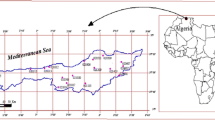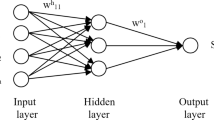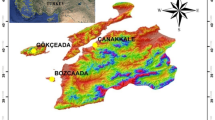Abstract
The intensity and frequency of diverse hydro-meteorological disasters viz., extreme droughts, severe floods, and cyclones have increasing trends due to unsustainable management of land and water resources, coupled with increasing industrialization, urbanization and climate change. This study focuses on the forecasting of drought using selected Artificial Neural Network (ANN)-based models to enable decision-makers to improve regional water management plans and disaster mitigation/reduction plans. Four ANN models were developed in this study, viz., one conventional ANN model and three hybrid ANN models: (a) Wavelet based-ANN (WANN), (b) Bootstrap based-ANN (BANN), and (c) Wavelet-Bootstrap based-ANN (WBANN). The Standardized Precipitation Evapotranspiration Index (SPEI), the best drought index identified for the study area, was used as a variable for drought forecasting. Three drought indices, such as SPEI-3, SPEI-6 and SPEI-12 respectively representing “short-term”, “intermediate-term”, and “long-term” drought conditions, were forecasted for 1-month to 3-month lead times for six weather stations over the study area. Both statistical and graphical indicators were considered to assess the performance of the developed models. For the hybrid wavelet model, the performance was evaluated for different vanishing moments of Daubechies wavelets and decomposition levels. The best-performing bootstrap-based model was further used for analysing the uncertainty associated with different drought forecasts. Among the models developed for drought forecasting for 1 to 3 months, the performances of the WANN and WBANN models are superior to the simple ANN and BANN models for the SPEI-3, SPEI-6, and SPEI-12 up to the 3-month lead time. The performance of the WANN and WBANN models is the best for SPEI-12 (MAE = 0.091-0.347, NSE = 0.873-0.982) followed by SPEI-6 (MAE = 0.258-0.593; NSE = 0.487-0.848) and SPEI-3 (MAE = 0.332-0.787, NSE = 0.196-0.825) for all the stations up to 3-month lead time. This finding is supported by the WBANN analyze uncertainties as narrower band width for SPEI-12 (0.240-0.898) as compared to SPEI-6 (0.402-1.62) and SPEI-3 (0.474-2.304). Therefore, the WBANN model is recommended for the early warning of drought events as it facilitates the uncertainty analysis of drought forecasting results.









Similar content being viewed by others
Data availability
The data presented in this study are available on request from the corresponding author.
Abbreviations
- ANN:
-
Artificial Neural Network
- ARMA:
-
Autoregressive Moving Average
- BANN:
-
Bootstrap based-ANN
- CI:
-
Confidence Interval
- CWT:
-
Continuous Wavelet Transformation
- DL:
-
Decomposition Level
- DWT:
-
Discrete Wavelet Transformation
- EDI:
-
Effective Drought Index
- ENSO:
-
El Niño-Southern Oscillation
- ET:
-
Evapotranspiration
- MAE:
-
Mean Absolute Error
- MW:
-
Mother Wavelet
- NSE:
-
Nash-Sutcliffe Efficiency
- NADI:
-
Nonlinear Aggregated Drought Index
- PDN:
-
Precipitation Departure from Normal
- RMSE:
-
Root Mean Square Error
- SPEI:
-
Standardized Precipitation Evapotranspiration Index
- SPEI-3:
-
Standardized Precipitation Evapotranspiration Index with a 3-month scale
- SPEI-6:
-
Standardized Precipitation Evapotranspiration Index with a 6-month scale
- SPEI-12:
-
Standardized Precipitation Evapotranspiration Index with a 12-month scale
- SPI:
-
Standardized Precipitation Index
- WANN:
-
Wavelet based-ANN
- WBANN:
-
Wavelet-Bootstrap –based ANN
- WT:
-
Wavelet Transformation
References
Adamowski, J. F. (2008). Development of a short-term river flood forecasting method for snowmelt driven floods based on wavelet and cross-wavelet analysis. Journal of Hydrology, 353(3), 247–266.
AghaKouchak, A., Pan, B., Mazdiyasni, O., Sadegh, M., Jiwa, S., Zhang, W., et al. (2022). Status and prospects for drought forecasting: opportunities in artificial intelligence and hybrid physical–statistical forecasting. Philosophical Transactions of the Royal Society A, 380(2238), 20210288.
Alawsi, M. A., Zubaidi, S. L., Al-Bdairi, N. S. S., Al-Ansari, N., & Hashim, K. (2022). Drought forecasting: a review and assessment of the hybrid techniques and data pre-processing. Hydrology, 9(7), 115. https://doi.org/10.3390/hydrology9070115
Allen, R. G., Perevia, L. S., Raes, D., & Smith, M. (1998). Crop Evapotranspiration: Guidelines for Computing Crop Water Requirements. In FAO Irrigation and Drainage Paper No. 56, Food and Agriculture Organization (FAO).
Anshuka, A., van Ogtrop, F. F., & Willem Vervoort, R. (2019). Drought forecasting through statistical models using standardised precipitation index: a systematic review and meta-regression analysis. Natural Hazards, 97, 955–977.
ASCE. (2000a). Application of Artificial Neural Networks in Hydrology. Artificial neural networks in hydrology I: Preliminary concepts. Journal of Hydrologic Engineering, 5(2), 115–123.
ASCE. (2000b). Application of Artificial Neural Networks in Hydrology. Artificial neural networks in hydrology II: Hydrologic Applications. Journal of Hydrologic Engineering, 5(2), 124–137.
Behrangi, A., Nguyen, H., & Granger, S. (2015). Probabilistic seasonal prediction of meteorological drought using the bootstrap and multivariate information. Journal of Applied Meteorology and Climatology, 54(7), 1510–1522.
Belayneh, A., & Adamowski, J. (2012). Standard precipitation index drought forecasting using neural networks, wavelet neural networks, and support vector regression. Applied Computational Intelligence and Soft Computing, Article, 794061, 13. https://doi.org/10.1155/2012/794061
Belayneh, A., Adamowski, J., Khalil, B., & Ozga-Zielinski, B. (2014). Long-term SPI drought forecasting in the Awash River Basin in Ethiopia using wavelet neural network and wavelet support vector regression models. Journal of Hydrology, 508, 418–429.
Belayneh, A., Adamowski, J., Khalil, B., & Quilty, J. (2016). Coupling machine learning methods with wavelet transforms and the bootstrap and boosting ensemble approaches for drought prediction. Atmospheric Research, 172, 37–47.
Beven, K. (2006). A manifesto for the equifinality thesis. Journal of Hydrology, 320(1), 18–36.
Beyaztas, U., Arikan, B. B., Beyaztas, B. H., & Kahya, E. (2018). Construction of prediction intervals for Palmer Drought Severity Index using bootstrap. Journal of Hydrology, 559, 461–470.
Bogner, K., & Pappenberger, F. (2011). Multiscale error analysis, correction, and predictive uncertainty estimation in a flood forecasting system. Water Resources Research, 47. https://doi.org/10.1029/2010WR009137
Byun, H. R., & Wilhite, D. A. (1999). Objective quantification of drought severity and duration. Journal of Climatology, 12, 2747–2756.
Cannas, B., Fanni, A., See, L., & Sias, G. (2006). Data preprocessing for river flow forecasting using neural networks: wavelet transforms and data partitioning. Physics and Chemistry of the Earth, Parts A/B/C, 31(18), 1164–1171.
Crespo, J. L., & Mora, E. (1993). Drought estimation with neural networks. Advances in Engineering Software, 18(3), 167–170.
Deo, R. C., & Şahin, M. (2015). Application of the artificial neural network model for prediction of monthly standardized precipitation and evapotranspiration index using hydro-meteorological parameters and climate indices in eastern Australia. Atmospheric Research, 161, 65–81.
Dikshit, A., Pradhan, B., & Alamri, A. M. (2020). Temporal hydrological drought index forecasting for New South Wales, Australia using machine learning approaches. Atmosphere, 11(6), 585. https://doi.org/10.3390/atmos11060585
Djerbouai, S., & Souag-Gamane, D. (2016). Drought forecasting using neural networks, wavelet neural networks, and stochastic models: case of the Algerois Basin in North Algeria. Water Resources Management, 30(7), 2445–2464.
Efron, B., & Tibshirani, R. J. (1993). An Introduction to the Bootstrap. Chapman and Hall.
Fung, K. F., Huang, Y. F., Koo, C. H., & Soh, Y. W. (2020). Drought forecasting: A review of modelling approaches 2007–2017. Journal of Water and Climate Change, 11(3), 771–799.
Hailegeorgis, T. T., Thorolfsson, S. T., & Alfredsen, K. (2013). Regional frequency analysis of extreme precipitation with consideration of uncertainties to update IDF curves for the city of Trondheim. Journal of Hydrology, 498, 305–318.
Han, D., Kwong, T., & Li, S. (2007). Uncertainties in real-time flood forecasting with neural networks. Hydrological Processes, 21(2), 223–228.
Hargreaves, G. H., & Samani, Z. A. (1985). Reference crop evapotranspiration from temperature. Applied Engineering in Agriculture, 1(2), 96–99.
Haykin, S. (1994). Neural Networks. Macmillan College Publishing Company, Inc.
Hinge, G., Piplodiya, J., Sharma, A., Hamouda, M. A., & Mohamed, M. M. (2022). Evaluation of Hybrid Wavelet Models for Regional Drought Forecasting. Remote Sensing, 14(24), 6381. https://doi.org/10.3390/rs14246381
Hong, X., Guo, S., Zhou, Y., & Xiong, L. (2015). Uncertainties in assessing hydrological drought using streamflow drought index for the upper Yangtze River basin. Stochastic Environmental Research and Risk Assessment, 29(4), 1235–1247.
Hu, Y. M., Liang, Z. M., Liu, Y. W., Wang, J., Yao, L., & Ning, Y. (2015). Uncertainty analysis of SPI calculation and drought assessment based on the application of Bootstrap. International Journal of Climatology, 35(8), 1847–1857.
Huang, Y. F., Mirzaei, M., & Amin, M. Z. M. (2016). Uncertainty quantification in rainfall intensity duration frequency curves based on historical extreme precipitation quantiles. Procedia Engineering, 154, 426–432.
Jha, M. K. (Ed.). (2010). Natural and Anthropogenic Disasters: Vulnerability, Preparedness and Mitigation (pp. 1–18). Springer, Berlin, Germany and Capital Publishing Company, New Delhi, India.
Jha, M. K., & Sahoo, S. (2015). Efficacy of neural network and genetic algorithm techniques in simulating spatio-temporal fluctuations of groundwater. Hydrological Processes, 29(5), 671–691.
Jia, Y., & Culver, T. B. (2006). Bootstrapped artificial neural networks for synthetic flow generation with a small data sample. Journal of Hydrology, 331(3-4), 580–590.
Kasiviswanathan, K. S., & Sudheer, K. P. (2017). Methods used for quantifying the prediction uncertainty of artificial neural network based hydrologic models. Stochastic Environmental Research and Risk Assessment, 31, 1659–1670.
Katipoğlu, O. M. (2022). Prediction of future hydrological droughts with tree-based algorithms. International Journal of Engineering Science, 51, 51–70.
Katipoğlu, O. M. (2023). Prediction of streamflow drought index for short-term hydrological drought in the semi-arid Yesilirmak Basin using Wavelet transform and artificial intelligence techniques. Sustainability, 15(2), 1109. https://doi.org/10.3390/su15021109
Katipoğlu, O. M., & Acar, R. (2022). Space-time variations of hydrological drought severities and trends in the semi-arid Euphrates Basin, Turkey. Stochastic Environmental Research and Risk Assessment, 36, 4017–4040.
Keshavarz, M., Karami, E., & Vanclay, F. (2013). The social experience of drought in rural Iran. Journal of Land Use Policy, 30, 120–129.
Keskin, M. E., Terzi, O., Taylan, E. D., & Kucukyaman, D. (2011). Meteorological drought analysis using artificial neural networks. Scientific Research and Essays, 6(21), 4469–4477.
Khalil, A. F., McKee, M., Kemblowski, M., Asefa, T., & Bastidas, L. (2006). Multiobjective analysis of chaotic dynamic systems with sparse learning machines. Advances in Water Resources, 29(1), 72–88.
Khan, M. M. H., Muhammad, N. S., & El-Shafie, A. (2020). Wavelet based hybrid ANN-ARIMA models for meteorological drought forecasting. Journal of Hydrology, 590, 125380. https://doi.org/10.1016/j.jhydrol.2020.125380
Kim, T. W., & Valdés, J. B. (2003). Nonlinear model for drought forecasting based on a conjunction of wavelet transforms and neural networks. Journal of Hydrologic Engineering, ASCE, 8(6), 319–328.
Liu, Y. W., Wang, W., Hu, Y. M., & Liang, Z. M. (2014). Drought assessment and uncertainty analysis for Dapoling basin. Natural Hazards, 74(3), 1613–1627.
Maheswaran, R., & Khosa, R. (2012). Comparative study of different wavelets for hydrologic forecasting. Computers & Geosciences, 46, 284–295.
Maier, H. R., & Dandy, G. C. (2000). Neural networks for the prediction and forecasting of water resources variables: A review of modeling issues and applications. Environmental Modeling and Software, 15, 101–124.
Mallat, S. G. (1989). A theory for multiresolution signal decomposition: the wavelet representation. IEEE Transactions on Pattern Analysis and Machine Intelligence, 11(7), 674–693.
Masud, M. B., Khaliq, M. N., & Wheater, H. S. (2015). Analysis of meteorological droughts for the Saskatchewan River Basin using univariate and bivariate approaches. Journal of Hydrology, 522, 452–466.
Mélèse, V., Blanchet, J., & Molinié, G. (2018). Uncertainty estimation of Intensity–Duration–Frequency relationships: A regional analysis. Journal of Hydrology, 558, 579–591.
Mirzaei, M., Huang, Y. F., El-Shafie, A., Chimeh, T., Lee, J., Vaizadeh, N., & Adamowski, J. (2015). Uncertainty analysis for extreme flood events in a semi-arid region. Natural Hazards, 78, 1947–1960.
Mishra, A. K., & Desai, V. R. (2006). Drought forecasting using feed-forward recursive neural network. Ecological Modeling, 198, 127–138.
Mishra, A. K., Desai, V. R., & Singh, V. P. (2007). Drought forecasting using a hybrid stochastic and neural network model. Journal of Hydrologic Engineering, ASCE, 12(6), 626–638.
Młyński, D., Wałęga, A., & Kuriqi, A. (2021). Influence of meteorological drought on environmental flows in mountain catchments. Ecological Indicators, 133, 108460.
Mohapatra, J. B., Jha, P., Jha, M. K., & Biswal, S. (2021). Efficacy of machine learning techniques in predicting groundwater fluctuations in agro-ecological zones of India. Science of the Total Environment, 785, 147319. https://doi.org/10.1016/j.scitotenv.2021.147319
Morid, S., Smakhtin, V., & Bagherzadeh, K. (2007). Drought forecasting using artificial neural networks and time series of drought indices. International Journal of Climatology, 27(15), 2103–2111.
Mulualem, G. M., & Liou, Y. A. (2020). Application of artificial neural networks in forecasting a standardized precipitation evapotranspiration index for the Upper Blue Nile basin. Water, 12(3), 643.
Ng, J. L., Abd Aziz, S., Huang, Y. F., Mirzaei, M., Wayayok, A., & Rowshon, M. K. (2019). Uncertainty analysis of rainfall depth duration frequency curves using the bootstrap resampling technique. Journal of Earth System Science, 128, 1–15.
Nguyen, Q. H., Ly, H. B., Ho, L. S., Al-Ansari, N., Le, H. V., Tran, V. Q., et al. (2021). Influence of data splitting on performance of machine learning models in prediction of shear strength of soil. Mathematical Problems in Engineering, 2021. https://doi.org/10.1155/2021/4832864
Nourani, V., Baghanam, A. H., Adamowski, J., & Kisi, O. (2014). Applications of hybrid wavelet–artificial intelligence models in hydrology: a review. Journal of Hydrology, 514, 358–377.
Ochoa-Rivera, J. C. (2008). Prospecting droughts with stochastic artificial neural networks. Journal of Hydrology, 352(1), 174–180.
Overeem, A., Buishand, A., & Holleman, I. (2008). Rainfall depth-duration-frequency curves and their uncertainties. Journal of Hydrology, 348(1-2), 124–134.
PACS. (2004). Drought in India: Challenges and Initiatives. In Report of Poorest Areas Civil Society (PACS) Programme 2001-2008.
Partal, T. (2009). Modelling evapotranspiration using discrete wavelet transform and neural networks. Hydrological Processes, 23(25), 3545–3555.
Sahoo, S., & Jha, M. K. (2013). Groundwater-level prediction using multiple linear regression and artificial neural network techniques: a comparative assessment. Hydrogeology Journal, 21(8), 1865–1887.
Seo, Y., Kim, S., & Singh, V. P. (2013). Flood forecasting and uncertainty assessment using bootstrapped ANFIS. In Proceedings of 6th Conference of Asia Pacific Association of Hydrology and Water Resources, Seoul, South Korea, pp (pp. 1–8).
Shahfahad, Talukdar, S., Ali, R., Nguyen, K. A., Naikoo, M. W., Liou, Y. A., et al. (2022). Monitoring drought pattern for pre-and post-monsoon seasons in a semi-arid region of western part of India. Environmental Monitoring and Assessment, 194(6), 396. https://doi.org/10.1007/s10661-022-10028-5
Shirmohammadi, B., Moradi, H., Moosavi, V., Semiromi, M. T., & Zeinali, A. (2013). Forecasting of meteorological drought using Wavelet-ANFIS hybrid model for different time steps (case study: southeastern part of east Azerbaijan province, Iran). Natural Hazards, 69(1), 389–402.
Srivastav, R. K., Sudheer, K. P., & Chaubey, I. (2007). A simplified approach to quantifying predictive and parametric uncertainty in artificial neural network hydrologic models. Water Resources Research, 43(10). https://doi.org/10.1029/2006WR005352
Tufaner, F., & Özbeyaz, A. (2020). Estimation and easy calculation of the Palmer Drought Severity Index from the meteorological data by using the advanced machine learning algorithms. Environmental Monitoring and Assessment, 192, 1–14.
Twomey, J. M., & Smith, A. E. (1998). Bias and variance of validation methods for function approximation neural networks under conditions of sparse data. IEEE Transactions on Systems, Man, and Cybernetics, Part C (Applications and Reviews), 28(3), 417–430.
UNESCO Water Portal. (2008). Water and natural disasters in celebration of International Day for Natural Disaster Reduction. UNESCO Water Portal Bi-monthly Newsletter, No. 209, 14 October 2008, http://www.emwis.org/thematicdirs/news/unesco-water-portal-bi-monthly-newsletter-no-209
Vicente-Serrano, S. M., Beguería, S., & López-Moreno, J. I. (2010). A multiscalar drought index sensitive to global warming: the standardized precipitation evapotranspiration index. Journal of Climate, 23(7), 1696–1718.
Vicente-Serrano, S. M., Beguería, S., López-Moreno, J. I., Angulo, M., & El Kenawy, A. (2010). A new global 0.5 gridded dataset (1901–2006) of a multiscalar drought index: comparison with current drought index datasets based on the Palmer Drought Severity Index. Journal of Hydrometeorology, 11(4), 1033–1043.
Wable, P. S., & Jha, M. K. (2018). Application of Archimedean copulas to the impact assessment of hydro-climatic variables in semi-arid aquifers of western India. Hydrogeology Journal, 26(1), 89–108.
Wable, P. S., Jha, M. K., & Shekhar, A. (2018). Comparison of drought indices in a semi-arid river basin of India. Water Resources Management, 33(1), 75–102.
Wu, Z., Yin, H., He, H., & Li, Y. (2022). Dynamic-LSTM hybrid models to improve seasonal drought predictions over China. Journal of Hydrology, 615. https://doi.org/10.1016/j.jhydrol.2022.128706
Acknowledgements
The authors would like to acknowledge various government departments/institutions like India Meteorology Department, Pune, Mahatma Phule Agricultural University, Rahuri, and State Data Storage Centre, Nashik, for providing the required hydrometeorological data and information to carry out this study. The authors are also very grateful to the Associate Editor and reviewers for their helpful comments/suggestions that improved the manuscript significantly.
Funding
The first author is thankful to the Ministry of Human Resource Development (currently known as the Ministry of Education), New Delhi, India for the financial support through scholarship.
Author information
Authors and Affiliations
Contributions
Conceptualisation: Pawan S. Wable, Madan Kumar Jha; Methodology: Pawan S. Wable, Madan Kumar Jha; Software: Pawan S. Wable, Sirisha Adamala, Mukesh Kumar Tiwari; Data Collection: Pawan S. Wable; Writing-original draft preparation: Pawan S. Wable; Writing-review and editing: Madan Kumar Jha, Sirisha Adamala, Sabinaya Biswal; Supervision: Madan Kumar Jha. All the authors have read and agreed to the published version of the manuscript.
Corresponding author
Ethics declarations
Ethical Approval
This article does not contain any studies on human participants or animals performed by any authors. This study was done according to the ethical standards.
Ethical Responsibilities of Authors
All authors have read, understood, and have complied as applicable with the statement on "Ethical responsibilities of Authors" as found in the Instructions for Authors.
Consent to Participate
None.
Competing Interests
None.
Conflict of Interest
None.
Consent to Publish
None.
Additional information
Publisher’s Note
Springer Nature remains neutral with regard to jurisdictional claims in published maps and institutional affiliations.
Supplementary information
ESM 1
(DOCX 816 kb)
Rights and permissions
Springer Nature or its licensor (e.g. a society or other partner) holds exclusive rights to this article under a publishing agreement with the author(s) or other rightsholder(s); author self-archiving of the accepted manuscript version of this article is solely governed by the terms of such publishing agreement and applicable law.
About this article
Cite this article
Wable, P.S., Jha, M.K., Adamala, S. et al. Application of Hybrid ANN Techniques for Drought Forecasting in the Semi-Arid Region of India. Environ Monit Assess 195, 1090 (2023). https://doi.org/10.1007/s10661-023-11631-w
Received:
Accepted:
Published:
DOI: https://doi.org/10.1007/s10661-023-11631-w




